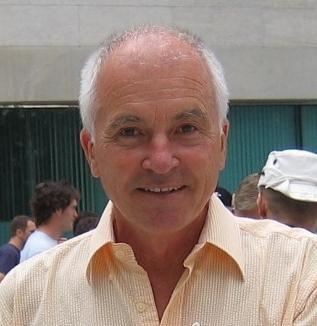ACM MSWiM 2019
TUTORIALS
The 22nd ACM MSWiM Conference includes the following tutorials:
Title: Connected Vehicles: The Road Ahead
Abstract:
Estimating traffic state parameters is a quintessential problem of traffic engineering. Over the past five decades, two broad classes of strategies have been developed to solve this problem. In the first such strategy, known as stationary observer (SO) method, stationary observers (e.g., pneumatic tubes, inductive loop detectors, cameras, microwave sensors, radars, etc.) placed by the roadside count the number of vehicles passing the observer in a given time interval. Having estimated their average speed one can readily estimate traffic density and traffic flow.
Several workers have recently pointed out that the SO method, and its myriad variants, yield accurate estimates but are quite expensive to field and maintain. In spite of this, the traffic estimates obtained by using the SO method are considered by many authors as benchmark values against which the accuracy of all other methods is assessed.
Back in 1954, Wardrop and Charlesworth proposed an alternate method for approximating traffic density and flow, known as the moving observer (MO) method. In essence, the MO method is implemented by a probe vehicle that drives a road segment several times, both in the traffic direction of interest and also in the opposite direction. As several authors have pointed out, the drawback of the original MO method is that in order to achieve results comparable to those offered by the SO method, the probe vehicle has to perform a significant number of runs in both directions. Unfortunately, all this takes time during which the traffic parameters may well change. Also, the original MO method does not take into account the reality of present-day cars, equipped with an entire panoply of on-board computing, sensing, and communication devices including DSRC-compliant radio transceivers, cameras, and an assortment of short- and long-range on-board radar devices.
In the 1990s US-DOT has initiated the development of Traffic Estimation and Prediction (TrEP) to enhance the mobility of ou transportation system. Two TrEP systems, namely DynaMIT and Dynasmart, were developed and several demonstration projects were conducted at various locations. Two key elements governing the success of TrEP are (i) how accurately can the system estimate and predict short-term traffic conditions in real-time and (ii) how well can the system model driver behavior and properly use this information for achieving better mobility and sustainability. Over the years, many researchers have enhanced the accuracy and performance of TrEP by considering weather conditions, by enhancing origin and destination demand, and by presenting/demonstrating calibration of supply parameters.
Recently, inspired by the increasing sophistication of present-day vehicles and motivated by advances in vehicular networking, the US-DOT has started promoting the Connected Vehicles (CV) technology. By using dedicated wireless connectivity between the vehicles participating in the traffic, the CV technology aims to promote an increased awareness of real-time traffic conditions and to reduce the number and severity of crashes. As it turns out, one of the benefits of the CV initiative is that decentralized real-time estimations of various traffic parameters, including traffic density can be derived without the need to involve pre-deployed infrastructure. An attractive feature of decentralized protocols is that both traffic data collection and the computation are performed locally by the vehicles involved in the traffic, rather than remotely in the cloud. This saves time without sacrificing computational accuracy, a definite plus. In addition, the CV technology ensures that the dissemination of the results occurs in real time using some flavor of Vehicle to Vehicle (V2V) or Vehicle to Infrastructure (V2I) communications.
Relying on traffic data collected by probe vehicles seems to work best in urban environments that experience high concentration of vehicles and less well on highways where there may be no “critical mass” of probe vehicles. Waze is a GPS-based geographical navigation application program for smartphones with GPS support and display screens which provides traffic status information from driver-submitted location-dependent traffic status information along with travel times and route details. Waze is a centralized system where the entire communication takes
place over the mobile telephone network.
This tutorial will review the challenges and opportunities offered by the CV technology for making real-time traffic parameter estimation reality. Several other application domains will be discussed.
Speaker:
 Stephan Olariu received his B.Sc., M.Sc., and PhD from McGill University, Montreal, Canada in 1981, 1983 and 1986, respectively. Much of his experience has been with the design and implementation of robust protocols for intelligent transportation systems and their applications to smart cities. His most recent research interests are in the area of vehicular clouds. He has published extensively in IEEE Transactions on Intelligent Transportation Systems and IEEE Intelligent Transportation Systems Magazine.
Stephan Olariu received his B.Sc., M.Sc., and PhD from McGill University, Montreal, Canada in 1981, 1983 and 1986, respectively. Much of his experience has been with the design and implementation of robust protocols for intelligent transportation systems and their applications to smart cities. His most recent research interests are in the area of vehicular clouds. He has published extensively in IEEE Transactions on Intelligent Transportation Systems and IEEE Intelligent Transportation Systems Magazine.
Title: Future Generations of Vehicular Autonomous Networks: What Modeling and Simulation can do for the new generation of cars?
Abstract:
networking
scenarios as the current advances in vehicular communication
technologies and connected cars penetrate on the market. However,
current data dissemination protocols and even the host-centric
content delivery paradigm will not support the anticipated traffic
load without degrading vehicular applications QoS/QoE. Recent
research efforts are proposing the information-centric networking
paradigm as a viable solution for handling multimedia content distribution
in vehicular networks and connected and autonomous
vehicles. This tutorial will motivate and explore the challenges, design
principles and goals of information-centric content distribution for
intelligent vehicular networks.We shall present the building blocks
for the design of protocols for information-centric content distribution
in vehicular networks. We shall discuss several challenges the
information-centric networking paradigm faces in the scenarios
of vehicular networks and connected cars. We shall present the
current proposals in the literature and provide some guidelines
for the further design of information-centric Intelligent vehicular
networks. Finally, we shall conclude the talk with a discussion of research opportunities and challenges in information-centric
intelligent vehicular networks.
Speakers:
 Floriano De Rango is Professor of Telecommunicaiton and Networking Technologies at the Department of Information Technologies, Modeling, Electronics and Systems (DIMES), at University of Calabria, Italy. His research interests include modelling and simulation, networking technologies, wireless networks. He has more than 230 refereed research publications with a Google Scholar citation count of more than 2700 and an h-index of 32. He founded some companies working in the filed of Internet of Thnìngs and Smart Cities such as Spintel Ltd (www.spintel.it) and Firefly Ltd. He is involved in international conference organization chairing events such as Summer Simulation Conference (SCS), Simultech, Wireless Days, Consumer Communication and Networking Conference (CCNC), KTTO, DS-RT. More details can be found to the following link: http://culture.deis.unical.it/derango/ .
Floriano De Rango is Professor of Telecommunicaiton and Networking Technologies at the Department of Information Technologies, Modeling, Electronics and Systems (DIMES), at University of Calabria, Italy. His research interests include modelling and simulation, networking technologies, wireless networks. He has more than 230 refereed research publications with a Google Scholar citation count of more than 2700 and an h-index of 32. He founded some companies working in the filed of Internet of Thnìngs and Smart Cities such as Spintel Ltd (www.spintel.it) and Firefly Ltd. He is involved in international conference organization chairing events such as Summer Simulation Conference (SCS), Simultech, Wireless Days, Consumer Communication and Networking Conference (CCNC), KTTO, DS-RT. More details can be found to the following link: http://culture.deis.unical.it/derango/ .
|
 Stephan Olariu received his B.Sc., M.Sc., and PhD from McGill University, Montreal, Canada in 1981, 1983 and 1986, respectively. Much of his experience has been with the design and implementation of robust protocols for intelligent transportation systems and their applications to smart cities. His most recent research interests are in the area of vehicular clouds. He has published extensively in IEEE Transactions on Intelligent Transportation Systems and IEEE Intelligent Transportation Systems Magazine.
Stephan Olariu received his B.Sc., M.Sc., and PhD from McGill University, Montreal, Canada in 1981, 1983 and 1986, respectively. Much of his experience has been with the design and implementation of robust protocols for intelligent transportation systems and their applications to smart cities. His most recent research interests are in the area of vehicular clouds. He has published extensively in IEEE Transactions on Intelligent Transportation Systems and IEEE Intelligent Transportation Systems Magazine.
 Floriano De Rango is Professor of Telecommunicaiton and Networking Technologies at the Department of Information Technologies, Modeling, Electronics and Systems (DIMES), at University of Calabria, Italy. His research interests include modelling and simulation, networking technologies, wireless networks. He has more than 230 refereed research publications with a Google Scholar citation count of more than 2700 and an h-index of 32. He founded some companies working in the filed of Internet of Thnìngs and Smart Cities such as Spintel Ltd (www.spintel.it) and Firefly Ltd. He is involved in international conference organization chairing events such as Summer Simulation Conference (SCS), Simultech, Wireless Days, Consumer Communication and Networking Conference (CCNC), KTTO, DS-RT. More details can be found to the following link: http://culture.deis.unical.it/derango/ .
Floriano De Rango is Professor of Telecommunicaiton and Networking Technologies at the Department of Information Technologies, Modeling, Electronics and Systems (DIMES), at University of Calabria, Italy. His research interests include modelling and simulation, networking technologies, wireless networks. He has more than 230 refereed research publications with a Google Scholar citation count of more than 2700 and an h-index of 32. He founded some companies working in the filed of Internet of Thnìngs and Smart Cities such as Spintel Ltd (www.spintel.it) and Firefly Ltd. He is involved in international conference organization chairing events such as Summer Simulation Conference (SCS), Simultech, Wireless Days, Consumer Communication and Networking Conference (CCNC), KTTO, DS-RT. More details can be found to the following link: http://culture.deis.unical.it/derango/ .